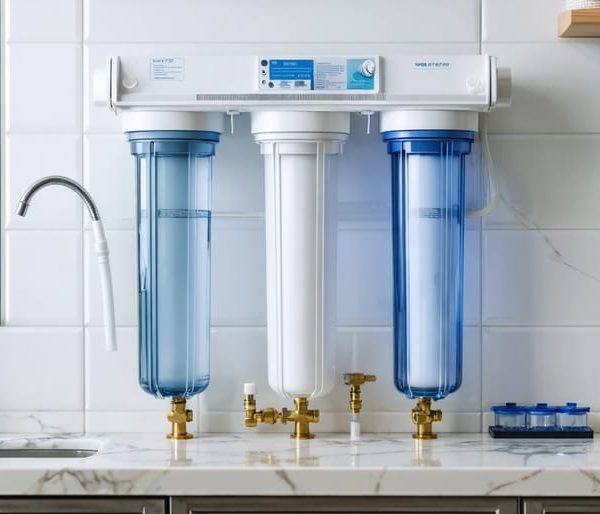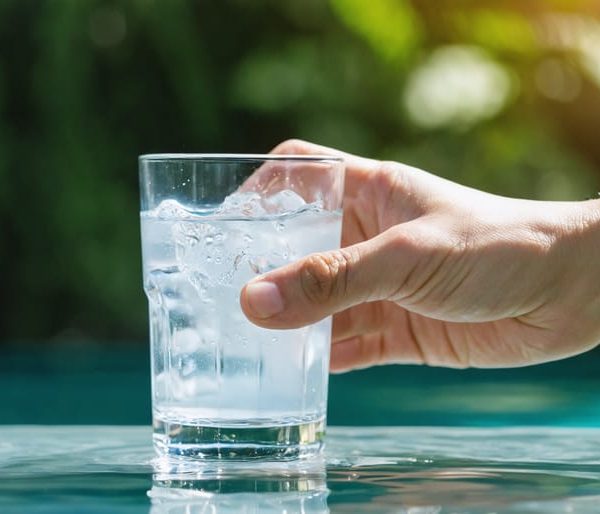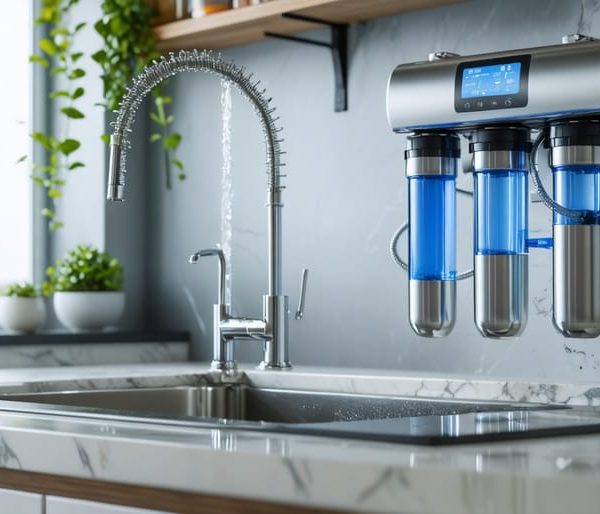The water conditioner vs water softener battle points to the production of soft water. Giving a verdict on which of these options is better may not be as straightforward as it seems. However, the main difference between a water conditioner and a water softener is simple:
A water conditioner neutralizes hard water minerals such as calcium and magnesium, so they don’t glue themselves to surfaces or pipes but still keep them in the water. A water softener removes calcium and magnesium and releases sodium ions or potassium in their place. This process is called ion exchange.
Simply put, while the water conditioner neutralizes water hardness and leaves these minerals in the water, the water softener eliminates them.
These terms can be puzzling to laymen, so let’s start discussing each of these water treatment options.
What Are Water Conditioners?
Water conditioners are salt-free systems that utilize a process known as TAC (template-assisted crystallization) to neutralize calcium and magnesium in hard water.
While water softeners usually have two tanks, water conditioners have a single tank called the resin tank. A major component of this tank is the resin bed or resin beads. Once the hard water comes in contact with the tank of water conditioners, the calcium and magnesium ions glue to the resin bed. Then, they begin to change, become bigger, and eventually crystallize. Once these hard minerals transform into crystals, the resin bed releases them into the water. So, they are still present in the water, but they are less harmful to your pipes and appliances.
Calcium and magnesium ions cannot clog pipes and stick on surfaces, and appliances in their crystallized form. This also means there will be no formation of scales, which is good news for you.
Salt-free water softeners and water conditioners are just different names for a single water filter.
Types of Water Conditioners
The types of water conditioners include the following:
Electronic Descaler Water Conditioner
An electronic water descaler uses electrical energy to suspend or distort hard minerals and other kinds of water minerals. This kind of process leaves residues on an electrode that will require sanitizing at regular intervals, depending on usage level.
These precipitated forms can make surfaces like a heating agent muddy. However, it can easily be removed when the water is moving at high speeds close to the surface.
Template-Assisted Crystallization
TAC is the most popular water conditioner or salt-free water softener. It uses a template made of resin beads to transform the chemical make-ups of magnesium and calcium. This way, they become crystallized and incapable of leaving scale deposits in pipes, appliances, and surfaces. These crystallized minerals are then released back into the water. These crystals are no longer soluble, and this makes them harmless to the home.
Magnetic Water Conditioner
This salt-free softener uses a magnetic coil to condition hard water. The coil emits an electromagnetic spectrum through which the water passes.
This electromagnetic field supposedly neutralizes these minerals in the water. This way, they cannot leave scales on appliances and surfaces in the home. However, its effectiveness is debatable. The technology behind this water conditioner remains questionable.
Electrolysis
This type of water conditioner uses a battery and metallic electrodes. These electrodes are placed in the water, where they emit positively charged zinc ions, which discharge electrons that flow to the cathode through the wire.
The electrolysis process only stops when the zinc anode is dissolved. This neutralizes the hard minerals in the water, but the effectiveness of this water conditioner is questionable. This is because once this conditioner is no longer in optimum condition, it won’t work on the hard water, and it usually gets like this without warning.
What Are Water Softeners
The salt-based water softener uses the ion exchange process to treat water hardness and produce soft water. The water goes into the resin tank, which contains the resin bed. This media contains sodium which is crucial for the production of soft water. This is why it’s referred to as a salt-based softener.
Once the water reaches the resin tank, the media draws magnesium and calcium from the hard water and glues them to its surface. Sodium is then released into the water before it flows out of the resin tank into the whole house.
Salt-based softeners from water filtration can even remove additional minerals in the water like an iron filter.
Water Conditioner and Water Softener Comparison
Below are some of the critical things to consider in water conditioner vs water softener. Distinguishing them will give you a better understanding of how each one functions and what sets them apart.
Performance
There are multiple things to consider regarding performance and which water treatment systems tackle water hardness better. They include:
Operational Speed
Regarding their speed in handling water hardness, the water conditioner tops with the advantage in water conditioner vs water softener. This is because the process of template-assisted crystallization is quicker than the ion exchange process. In the first process, the rate at which water is supplied is constant.
Thoroughness
When it comes to which of these water treatment systems is more thorough, water softeners would be the winner. The ion exchange process used by the salt-based water softener is more comprehensive in treating water hardness because they remove hard minerals. This is because soft water can’t be produced without using salt or sodium to replace magnesium and calcium in the water.
That’s why it’s a bit lesser in speed than template-assisted crystallization. However, the speed of each water filter can be matched if water softeners are the suitable capacity or size for the household or community. So here’s another point for water softeners in water softener vs water conditioner.
Water softeners can guarantee the elimination of scales better than water conditioners because the ion exchange process removes hard water minerals while the water conditioners merely transform their chemical composition. This is one of the primary differences between the conditioners and water softeners.
Due to the thoroughness of the salt-based softener in removing hard water minerals, it’s usually regarded as a compatible water filter with other water filters such as the reverse osmosis filter.
Water-efficiency
Water softeners periodically regenerate to flush out the accumulated hard water minerals trapped in its resin tank during the softening process. However, this regeneration process leads to wastage of water which is not good for the environment.
On the other hand, water conditioners are more water-efficient than water softeners. This is because water conditioning doesn’t involve removing hard water minerals but crystallizing them to not dissolve back into the water and cause scale buildup. So, there is no regeneration process to flush out the accumulated minerals.
This is one point in favor of the water conditioners in the comparison between conditioners and water softeners. Water efficiency also determines how much you spend on your water bill.
Due to the quantity of wastewater that results from the treatment by water softeners, your water bill will be much higher than if you were using a water conditioner.
The best way to circumvent this particular disadvantage is to acquire high-capacity water softeners. This is because they regenerate less frequently than the low-capacity or small-sized water softeners.
The Use of Electricity
Generally, water conditioners do not rely on electricity to condition water. For example, the most common water conditioners, template-assisted water conditioners, and magnetic conditioners do not rely on electrical energy to treat hard water.
So, the acquisition, use, and maintenance of a water conditioner are more pocket-friendly than a softener in the long run.
The regeneration periodically triggered by the salt-based softener uses electrical energy aside from releasing wastewater in the process.
Maintenance
The next thing to consider after installing these systems is maintenance.
With the water conditioner, you have an edge because you tend to spend very little on maintenance costs. The only form of maintenance involved with a water conditioner is replacing the filter that extracts contaminants responsible for giving your water a bad smell and taste. One can do this once in about six months or so. Then the resin beads, which are far more durable than the sediment filter, can be replaced once in nearly six years or more.
Contaminants such as sand, sludge, and certain chemicals are filtered out to ensure that the water is fit for drinking, among other uses. In terms of maintenance, the water conditioner is more convenient than salt-based water softeners.
The maintenance procedure for the salt-based water softener is more demanding. Firstly, you have to ensure that there are bags of salt ready to refill your sodium levels in the softener. The salt they use to soften hard water goes into the brine tank. This is the very reason their maintenance is more demanding.
Depending on the capacity of the water softener and the level of water usage, you will need to refill the sodium ions every two months. They also have a sediment filter that removes contaminants before the actual water softening. This filter is a vital component because these sediments are capable of damaging the water softener.
The filters and the resin beads will need periodic replacements as well. The filters’ replacement should be bi-monthly, and that of the resin beads can be after a decade of use.
Pricing and Operational Costs
There is no fixed price for either of these water treatment options because each make or brand has different market values. However, research has shown that salt-based softeners are more expensive than conditioners.
Softeners do not only fetch a higher price in the market, but they also cost more to maintain. Also, households that use the salt-based water softener pay a higher water bill because it frequently wastes water when it regenerates. They also cost higher to install because you might require the services of a plumber. This is because the installation process of this system isn’t that simple.
Conditioners have a lower price tag in the market. This is because they cost less to maintain, and households using them pay a lower water bill. In addition, they have a lower installation cost because they are easy to install.
Life Cycle
The life cycle or longevity of the softener is usually longer than that of the conditioner. However, the longevity of either system depends on the brand and quality. For example, salt-based softeners typically last for at least 15 years. However, they can last for as long as 20 years if maintained well.
Conditioners, on the other hand, last for at least 6-7 years. They can last for as long as ten years or even more if maintained well.
Last Words
We can not tell you to pick one over the other. Instead, with the knowledge of both water systems, deciding which one to purchase should depend on what you need.
Some buyers prefer their water to contain calcium and magnesium in a harmless state to their pipes, surfaces, and appliances. In that case, water conditioners are the ideal choice.
They both prevent or inhibit the development of scales, but if you are insistent on using soft water, a water softener is the best option.



